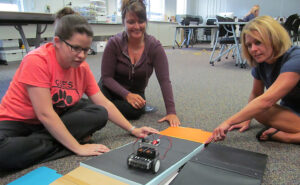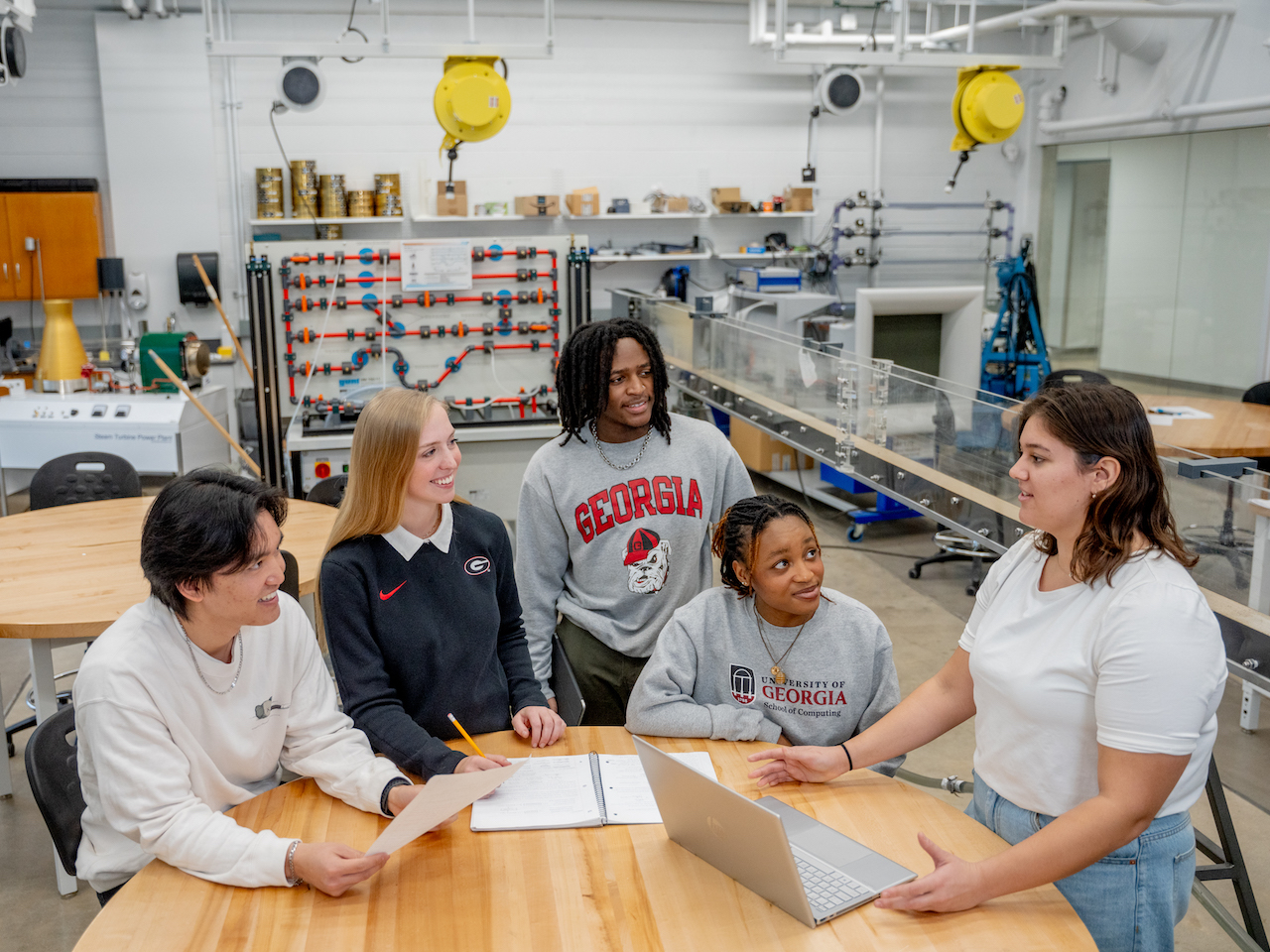 A two-year-long instructional project for 40 local K-8 teachers to incorporate robotics in their science, technology and mathematics curriculum is having a dramatic impact on student learning. The Robotics Activities for Teaching Science, Technology, Engineering and Mathematics (RAFTSTEM) workshops have already proven that Jackson County students as young as first grade are absorbing complex concepts through the use of robots in the classroom.
A two-year-long instructional project for 40 local K-8 teachers to incorporate robotics in their science, technology and mathematics curriculum is having a dramatic impact on student learning. The Robotics Activities for Teaching Science, Technology, Engineering and Mathematics (RAFTSTEM) workshops have already proven that Jackson County students as young as first grade are absorbing complex concepts through the use of robots in the classroom.
The University of Georgia College of Education and the College of Engineering, long-standing partners in STEM education and with the Jackson County school system, sponsored a series of ongoing workshops since 2014 for this project through a nearly $174,000 grant funded by the Georgia Department of Education.
“For the last 12 years faculty in the two UGA colleges have worked with teachers in Jackson County on a number of STEM education training workshops through total grant funding of almost $750,000,” says Roger Hill, professor of career and information studies in the College of Education and co-writer of the grant.
This particular RAFTSTEM project, however, is developing early career paths for students in a region where technology and science and the use of robotics are booming, particularly in large companies in Jackson County and the Athens area like Kubota, Toyota and Caterpillar, as well as hospitals and healthcare facilities that regularly use robotics in surgeries and medical procedures. According to research completed for the grant application, Jackson County presently exports more than 50% of its labor force because of lack of existing job skills—which is why the University of Georgia is looking to make an impact on the region with a high potential for growth in STEM careers.
“For faculty in the College of Engineering, this project is a great opportunity to apply concept-knowledge (C-K) design principles in an environment outside of the manufacturing world,” says Tim Foutz, Meigs Distinguished Professor of Engineering. “C-K design focuses on creativity. You develop an idea which at first appears not possible, then you determine what knowledge is needed to make the idea possible. If the knowledge does not exist, then you conduct research to generate the knowledge.”
The RAFTSTEM project, which includes teachers from five elementary and two middle schools, has introduced robotics as a learning tool to reinforce basic science and mathematics concepts, as well as problem-based learning—and it’s working even better than they had anticipated.
“The teachers have applied what they’ve learned in the workshops into their classrooms. They’ve incorporated the robotics into their curriculum, which has improved instruction,” says Deborah Riddleberger, Jackson County schools science coordinator. “If there’s something not working or [the teachers] need to adjust based on classroom learning outcomes, they come back to the next workshop and see how to improve it. It’s all based on what the teachers need.”
This cohort of 40 teachers has assembled periodically over the last two years, including a week-long workshop for the last two summers. . The RAFTSTEM teachers were first introduced to robotics during the poster session presented by students in the 2014 fall semester ETES 2320 course “Creative Activities for Teachers Laboratory.” The technological studies course through the College of Education allows students to participate in hands-on learning, including “problem solving, designing, construction, and testing of prototypes, and activities that increase aesthetic, psychomotor, and cognitive development.”
“The interactions between teachers and students is always good, as it brings realistic questions and valuable critique of student lesson plans and instructional materials,” says Hill.
The second summer workshop wrapped up in July with an intensive competition between teams for the most innovative programming of synchronized robots. The teachers were required to build their robots from RoboRobo kits and then program each team member’s robot to perform a choreographed performance following a storyline or script. Some of the teachers used the Olympics as a theme, including a track and field race and synchronized swimming competition. Others chose storybook themes, like the Three Little Pigs or Charlotte’s Web, while another chose synchronized hip-hop dancing.
They discovered through programming the robots they had to incorporate mathematics to configure the angles of the turns of each robot, science to determine velocity and timing, engineering to construct the robots, and technology to make the robots move as planned. And they also discovered that creating their story script required collaboration and effective communication in order to achieve their desired outcomes, which are valuable skills in today’s workforce.
In the two years the teachers have been utilizing robots in their classrooms, they’ve found that students understand far more about technology than they thought they would, even as young as first grade.
Amy Tinnel uses the RoboRobo kits funded by the grant to teach her first and second grade students at West Jackson Elementary School basic concepts of following instructions, building, mathematics—and for some students, doing basic programming, like making the robot do turns.
“Our first and second graders are learning about 60- and 90-degree angles well before this concept is introduced in later grades,” says Tinnel.
Tinnel also incorporates robotics into her fourth grade class, who each selected from one of four robot designs in their kit and were required to program it to do three different tasks. Then created video commercials to promote their “product” to their classmates.
“They loved it. And it made them use their imagination and writing skills to come up with their commercials.”
Tinnel was so encouraged by what her students are learning that she entered her science plans in the Atlanta Science Festival contest for science, space and radio communication. The contest challenge was to come up with a way to use robotics to communicate with astronauts in outer space. Tinnel had already developed a lesson plan for students to program lights on a robot into Morse Code, so she decided to give it a shot and enter her plan in the contest. To her surprise, her plan was only one of five selected in the state of Georgia, which allowed her class to present the robots at the festival. However, the ultimate prize was to take them to the Fernbank Planetarium in Atlanta and communicate with real astronauts on the international space station using their robot.
“Never in a million years would I have been able to do this without this [RAFTSTEM robotics] course,” says Tinnel. “The bonus was when seven out of 15 of our students’ questions for the astronauts were selected to be asked while we were there. There were only 10 total questions allowed, so only three questions were from the other schools. To me, that says a lot about what this program has done for us.”
Teachers at Gum Springs Elementary have found the use of robotics in their classrooms to be surprisingly more than what they anticipated.
“It’s been so engaging for the kids using robotics, and they’re learning that it’s okay to make mistakes and try something else,” says Kathy Venable, fifth grade mathematics and science teacher. “That’s a good skill to have in the sciences.”
“Some kids who aren’t good at ‘school’ are good at building robots. Some of those kids have demonstrated skills in robotics and stepped out as leaders,” says Jennifer Ellis, fifth grade language arts teacher. “One kid just shined when the robots were introduced, and he was tested for the gifted program because of it—and he was an ESOL student,” says Ellis.
Middle school students are exposed to even more complex concepts using robotics. Thomas Layfield, who teaches earth and life science at East Jackson Middle School, uses robots in his sixth and seventh grade classrooms to make a robotic Venus fly trap to carry out scientific investigations.
By the time students reach Robert Andrews’ eighth grade business and consumer sciences class at East Jackson Middle School, they know how to construct, engineer and program a robot.
“This curriculum prepares them for the high school computer science pathway,” says Andrews. “They know how to apply what they’ve learned to solve problems.”
This is good news for Jackson County industries, since the expectation is that more students graduating with a higher degree of technology skillsets will be ready for the workforce or will go to college to get a degree in technology and return to the area.
While this RAFTSTEM project is wrapping up this fall, the workshops have made a lasting impact on the teachers and their ability to teach STEM subject areas in a more organic process. Even though it’s too early for collecting data on the impact of the program, it’s clear students are eager to absorb knowledge in new ways that coincide with the technological advanced society into which they were born.
“The recent revisions in national English language standards have required teachers to focus more on composing non-fiction so that students will graduate and be able to live competently in a technological world and to not keep different subject matters in silos. Teachers now work to integrate subject matters, just like how learning occurs in real, everyday life. Learning becomes more natural,” says Hill.
The Office of STEM Education provides campus-wide leadership for STEM (Science, Technology, Engineering and Mathematics) activities. The OSE represents UGA in the University System of Georgia Board of Regents STEM Initiative, whose goals are to increase the number of students who succeed in STEM courses; increase the number of students who pursue baccalaureate degrees in STEM fields; and make science and mathematics teacher production a high priority to ease Georgia’s severe shortage of teachers in these subject areas. The Office of STEM Education partners with campus, state, and national initiatives designed to improve the quality of undergraduate STEM education and increase the diversity of talented students pursuing STEM careers.


